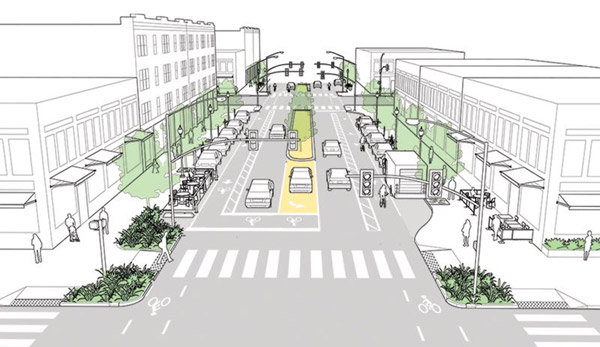For a long time, road engineering standards have been a bane of good city-building. Generally designed to enable cars and trucks to travel safely at high speeds in some generic setting, they have tended ignore the reality of tightly-spaced urban areas where pedestrians and cyclists share the right-0f-way with vehicles. But they get applied to cities because city staff do not want to be accused of deviating from the accepted standard when designing infrastructure.
This week, urban engineering took a big step forward with the release of the Urban Street Design Guide by the National Association of City Transportation Officials (NACTO) in the US. The guide provides engineering standards, developed by professionals, that are specifically designed for cities. They are meant to not only ensure the safety of all city users, including pedestrians, cyclists and transit users as well as drivers, but also create cities that are vibrant and appealing:
A blueprint for designing 21st century streets, the Guide unveils the toolbox and the tactics cities use to make streets safer, more livable, and more economically vibrant.
A good example of the difference the guide makes lies in the issue of corner radii — the curve in the sidewalk at the corner of an intersection than enables vehicles to turn without mounting the curb. Traditionally, these have been designed so that cars can turn comfortably without stopping, and so that trucks and buses can turn directly from right lane to right lane. The result has been wide radii that encourage cars to speed around corners dangerously, and lengthens the space that pedestrians have to cross (as the guide says, “Longer crosswalks take more time to cross, increasing pedestrian exposure risk and diminishing safety.”)
The new guidelines change all that. Their focus on corner radii lies in ensuring that intersections are tight, comfortable for pedestrians, and encourage vehicles to slow down before turning:
Minimizing turning speeds is crucial to pedestrian safety, as corners are where drivers are most likely to encounter pedestrians crossing in the crosswalk.
The new guide also accepts that, in an urban setting, buses and trucks almost always take an extra lane to make a turn. The result is a significant decrease in the recommended radii.
Crucially, the guide presents this new approach in terms that speak directly to traffic engineers, with detailed footnotes on supporting research, and provide them with the kind of explicit standards and formulas that they need to do their work.
With this new guide, urban traffic engineers can design streets for cities without feeling that they are straying from the standards — on the contrary, now they will be conforming to the standard. As this new standard is applied, it will gradually re-orient urban streets from being focused on vehicles to serving all street users.
These are the kinds of details that can make a huge difference for how we use and experience a city, especially for pedestrians. While this guide was developed in the United States, there’s no reason why it can’t apply in Canadian cities too. I’m hoping to hear that this will be the new standard for Toronto’s road infrastructure in the near future.
Image from NACTO Urban Street Design Guide






5 comments
I do hope to get through to the NACTO site to see this – it’s been busy it seems. It may be very relevant to TO to have another set of guidelines – we tend to wing it depending on what ward things are in, or if it is only a bike lane.
I especially want to see what they say about bi-directional lanes – like what Cycle Toronto is proposing to do on Harbord St. where mere Danish and Quebec better practices do not agree with what’s proposed ie. too many conflict points from too many intersections.
The southbound curve of the new Davenport/Bay intersection is also a pinch point for cyclists now, where we used to have a bike lane, but everyone’s ok with the new danger though there was plenty of room to eliminate a new traffic median meant for an urban highway. For safety I guess. But for cars, it’s only a bike lane, and heck, if they add a bit more across the intersection, then it zeroes out on the removal.
It’s good to have these standards, but one also needs progressive transportation services staff to implement them.
I’m pretty used to hearing weak excuses. When I went to a transportation workshop on amalgamating road widths, we were told the city was proposing wider 6 metre minimums due to the need to accommodate fire trucks. We later found out that fire services doesn’t use back lanes. When I brought this up to transportation consultations he said “well we don’t really expect to see many neighbourhoods with back lanes anyways”.
At least not with those space wasting (and costly) dimensions.
As for street widths the city proposed & enacted wider mandates to enable fire trucks (they’ve gotten very big) to pull a u-turn. Even when rebuilding Regent Park, the fire fighters came out to tell Council that if they didn’t get the widths, they couldn’t guarantee the safety of people in the new development, despite all of the surrounding streets being built to the existing narrower guidelines.
In Europe they build fire trucks to suit the city while in most of NA we redesign our cities to fit whatever fire truck manufacturers recommend.
The ridiculous road right of ways are causing a lot of developers to build private streets & pathways which are exempt from the mandates but are very problematic from a public space perspective.
We can’t let firetrucks dictate street widths because it degrades the safety and quality of streets for people on an everyday basis. Firefighters should stop buying larger trucks.
I was surprised to note that Mississauga has changed the corner radii at intersections in the City Centre area. Intersections on the north side of Burnhamthorpe Road that once had turn lanes and islands are now just continuous “squared-off” curbs.
The enlarged corners on the south side of Burnhamthorpe at Duke of York are home to a new sculpture set entitled “Migration”..http://www.mississauga.ca/portal/cityhall/pressreleases?paf_gear_id=9700020&itemId=1600186r…pretty good for Mississauga.
Cheers, Moaz
The redistribution of priority away from “cars first” and towards a more equitable sharing of space calls for a particular semantic shift – from “sidewalk” to “walkway.”
Brief – As Toronto continues to struggle with its transportation identity (walkable city? car-centric? transit-oriented? rideable?) it’s a great time to rescue walking from the stigma that sprawl has cast upon it; to re-elevate and make relevant walking as a functional, and safe mode of transportation, and an asset to our view of modal integration.
Expanded rationale – http://torontomyway.blogspot.ca/2013/06/not-sidewalkswalkways.html